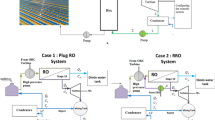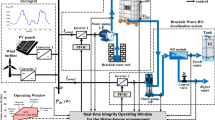Abstract
Water scarcity and the poor quality of water resources are leading to a wider diffusion of desalination plants using the Reverse Osmosis (RO) process. Unfortunately, the cost of a cubic meter of fresh water produced by an RO plants is still high and many efforts are in progress to increase the efficiency of the membranes used in osmotic plants and to limit the energy required by the process. A further reduction of the energy cost could be obtained by an optimal operation of the desalination plant so reducing the hourly energy cost, or by coupling the RO plant with an energy production plant based on direct osmosis (Pressure Retarded Osmosis PRO).
The economic viability of the desalination process has been analyzed until now without accounting for the integration of the RO plant with the existing water network. This analysis is developed in the present paper with reference to a hypothetical change of water supply in a real network, where a desalination plant is used to satisfy the fresh water demand. Several scenarios will be analyzed to assess the minimum cost of fresh water production and water supply to the network, including the use of energy recovery systems, such as an integrated use of RO and PRO processes, or the regulation of pressure at the network intake by a micro hydro power plant.






Similar content being viewed by others
Abbreviations
- RO:
-
Reverse Osmosis
- PRO:
-
Pressure Retarded Osmosis
- WSN:
-
Water Supply Network
- PRV:
-
Pressure Reduction Valve
- PAT:
-
Pump as Turbine
- ERD:
-
Energy Recovery Device
- HPP:
-
Hydro Power Plant
- VOS:
-
Variable Operating Strategy
- PES:
-
Pressure Exchange System
- S & P:
-
Store and Pump
- P & S:
-
Pump and Store
- DS:
-
Direct Supply
- SPS:
-
Seawater Pumping System
References
Akgul D, Çakmakcı M, Kayaalp N, Koyuncu I (2008) Cost analysis of seawater desalination with reverse osmosis in Turkey. Desalination 220(1–3):123–131. doi:10.1016/j.desal.2007.01.027
Altaee A, Sharif A (2015) Pressure retarded osmosis: advancement in the process applications for power generation and desalination. Desalination 356:31–46
Araujo LS, Ramos H, Coelho ST (2006) Pressure control for leakage minimisation in water distribution systems management. Water Resour Manag 20(1):133–149
Carravetta A, Del Giudice G, Fecarotta O, Ramos HM (2012) Energy production in water distribution networks: a PAT design strategy. Water Resour Manag 26(13):3947–3959
Carravetta A, Fecarotta O, Del Giudice G, Ramos H (2014a) Energy recovery in water systems by PATs: a comparisons among the different installation schemes. Procedia Eng 70:275–284
Carravetta A, Fecarotta O, Martino R, Antipodi L (2014b) PAT efficiency variation with design parameters. Procedia Eng 70:285–291
Carravetta A, Fecarotta O, Sinagra M, Tucciarelli T (2014c) Cost-benefit analysis for hydropower production in water distribution networks by a pump as turbine. J Water Resour Plan Manag 140(6):04014002. doi:10.1061/(ASCE)WR.1943-5452.0000384
Charcosset C (2009) A review on membrane processes and renewable energies for desalination. Desalination 245:214–231
Dai PD, Li P (2016) Optimal Pressure Regulation in Water Distribution Systems Based on an Extended Model for Pressure Reducing Valves. Water Resources Management, 1–16
De Marchis M, Fontanazza C, Freni G, La Loggia G, Napoli E, Notaro V (2011) Analysis of the impact of intermittent distribution by modelling the network-filling process. J Hydroinf 13(3):358–373
Fecarotta O, Aricò C, Carravetta A, Martino R, Ramos HM (2014) Hydropower potential in water distribution networks: pressure control by PATs. Water Resour Manag 29(3):699–714
Fecarotta O, Carravetta A, Ramos HM, Martino R (2016) An improved affinity model to enhance variable operating strategy for pumps used as turbines. J Hydraul Res 54(3):332–341. doi:10.1080/00221686.2016.1141804
Gaius-obaseki T (2010) Hydropower opportunities in the water industry. Int J Environ Sci 1(3):392–402
Ghobeity A, Mitsos A (2010) Optimal time-dependent operation of seawater reverse osmosis. Desalination 263(1–3):76–88. doi:10.1016/j.desal.2010.06.041
Kim J, Jeong K, Park MJ, Shon HK, Kim JH (2015) Recent advances in osmotic energy generation via pressure-retarded osmosis (PRO): a review. Energies 8:11821–11845. doi:10.3390/en81011821
Kimura S, Sourirajan S (1967) Analysis of data in reverse osmosis with porous cellulose acetate membranes. AICHE J 13(3):497–503
Loeb S (1998) Energy production at the Dead Sea by pressure-retarded osmosis: challenge or chimera? Desalination 120(3):247–262
Lu YY, Hu YD, Zhang XL, Wu LY, Liu QZ (2007) Optimum design of reverse osmosis system under different feed concentration and product specification. J Membr Sci 287(2):219–229
Marcovecchio MG, Mussati SF, Aguirre PA, Scenna NJ (2005) Optimization of hybrid desalination processes including multi stage flash and reverse osmosis systems. Desalination 182(1–3):111–122
McCool BC, Rahardianto A, Faria J, Kovac K, Lara D, Cohen Y (2010) Feasibility of reverse osmosis desalination of brackish agricultural drainage water in the San Joaquin Valley. Desalination 261(3):240–250
McNabola A, Coughlan P, Williams A (2011) The Technical and Economic Feasibility of Energy Recovery in Water Supply Networks. Proceedings of International Conference on Renewable Energy and Power Quality, Las Palmas de Gran Canaria, Spain. Vol. 1315
Prante JL, Ruskowitz JA, Childress AE, Achilli A (2014) RO-PRO desalination: an integrated low-energy approach to seawater desalination. Appl Energy 120:104–114. doi:10.1016/j.apenergy.2014.01.013
Prescott S, Ulanicki B (2008) Improved control of pressure reducing valves in water distribution networks. J Hydraul Eng ASCE 134(1):56–65
Punys P, Dumbrauskas A, Kvaraciejus A, Vyciene G (2011) Tools for small hydropower plant resource planning and development: a review of technology and applications. Energies 4:1258–1277
Ramos HM, Mello M, De P (2010) Clean power in water supply systems as a sustainable solution: from planning to practical implementation. Water Sci Technol 10(1):39–49
Reimund KK, McCutcheon JR, Wilson AD (2015) Thermodynamic analysis of energy density in pressure retarded osmosis: the impact of solution volumes and costs. J Membr Sci 487:240–248
Rossman, L.A. (2000) EPANET 2 User’s manual. United States Environmental Protection Agency, Cincinnati, U.S.A
Thompson J, Rahardianto A, Gu H, Uchymiak M, Bartman A, Hedrick M, Lara D, Cooper J, Faria J, Christofides PD, Cohen Y (2013) Rapid field assessment of RO desalination of brackish agricultural drainage water. Water Res 47(8):2649–2660
Thorsen T, Holt T (2009) The potential for power production from salinity gradients by pressure retarded osmosis. J Membr Sci Vol 335(1–2):103–110. doi:10.1016/j.memsci.2009.03.003
Vivas E, Maia R (2013) Economic valuation of drought impacts on urban water supply systems. Application to a Portuguese drought prone area. EWRA 8th International Conference on Water Resources Management in an Interdisciplinary and Changing Context, 26th–29th June
Walsky T, Bezts W, Posluzny E, Weir M, Withman B (2006) Modeling leakage reduction through pressure control. J Am Water Works Assoc 98(4):147–155
Wilf M (2005) RO, NF and membrane filtration technology for potable water applications. Seminar (February 14–17), L’Aquila, Italy, European Desalination Society
Xu Q, Chen Q, Ma J, Blanckaert K, Wan Z (2014) Water saving and energy reduction through pressure management in urban water distribution networks. Water Resour Manag 28(11):3715–3726
Zhu A, Christofides PD, Cohen Y (2009) Minimization of energy consumption for a two-pass membrane desalination: effect of energy recovery, membrane rejection and retentate recycling. J Membr Sci 339(1–2):126–137
Ziolkowska JR (2015) Is desalination affordable? – regional cost and price analysis. Water Resour Manag 29(5):1385–1397
Ziolkowska JR, Ziolkowski B (2016) Effectiveness of water Management in Europe in the twenty-first century. Water Resour Manag 30:2261–2274
Author information
Authors and Affiliations
Corresponding author
Rights and permissions
About this article
Cite this article
Carravetta, A., Fecarotta, O., Golia, U.M. et al. Optimization of Osmotic Desalination Plants for Water Supply Networks. Water Resour Manage 30, 3965–3978 (2016). https://doi.org/10.1007/s11269-016-1404-9
Received:
Accepted:
Published:
Issue Date:
DOI: https://doi.org/10.1007/s11269-016-1404-9




